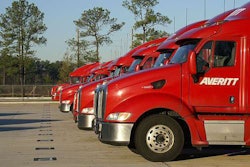
The American Transportation Research Institute on Wednesday, June 16, released the findings of its analysis of the efficacy and applicability of greenhouse gas reporting tools and emissions models to trucking industry operations. For companies developing a carbon accounting framework, the consistency of the accounting method and the appropriateness of the assumptions used to quantify emissions are two important areas of focus, ATRI’s research found.
The research determined a number of areas where further guidance is needed to better quantify the greenhouse gas emissions generated by motor carriers, and that precision may be sacrificed when data reporting is done at the energy consumer level, e.g. a motor carrier, as opposed to the energy producer level. Several organizations currently are working to refine the methods used to estimate greenhouse gas emissions, especially among the supply chain. Companies also are developing their own carbon calculators to help customers estimate the carbon impacts of the services they use. While the reporting tools generally are similar, there are differences between accounting methods that can impact the reported level of emissions.
Addressing greenhouse gas emissions is an emerging issue as the public and private sectors seek to quantify the carbon footprint associated with supply chains. In response, there is growing pressure on motor carriers to quantify greenhouse gas emissions. ”This research is critical for motor carriers seeking to identify potential sources of greenhouse gas emissions within their operations,” says Mike Naatz, president of YRC Worldwide’s Customer Care Division and Chief Customer Officer.
ATRI’s research identified both U.S. and international reporting tools and methodologies. Among the key findings were differences in the weighting of model inputs, which in turn impact the reported level of emissions. “ATRI’s study also highlights the need for industry involvement in standardizing approaches for carbon accounting,” says Naatz, a member of the ATRI Research Advisory, Committee which identified this research priority.
ATRI’s research found that for many motor carriers, the U.S. Environmental Protection Agency SmartWay Partnership Truck Model is the most widely recognized tool for quantifying greenhouse gas emissions. This model calculates emissions generated from a company’s on-road vehicle fleet. However, an individual company’s carbon footprint encompasses more than just its on-road vehicle fleet. Greenhouse gas emissions generally are divided into three distinct classifications or scopes.
Scope 1 includes direct emissions from the combustion of fuel as well as evaporative fluorocarbon emissions associated with the use of refrigerants. Potential Scope 1 emissions sources include trucks and ancillary equipment used to transport freight, such as those accounted for in the SmartWay model; mobile equipment used at company facilities, such as yard tractors and forklifts; stationary equipment used at company facilities, such as furnaces, generators and other onsite fuel-burning equipment; and air conditioning and/or refrigeration systems used in trucks and trailers as well as at company facilities.
Emissions factors for the various types of fuels and refrigerants used in this equipment generally are available; however, subtle differences exist among the various accounting tools. For instance, emissions factors for biodiesel were not consistent, and leakage rates among refrigerants varied by a factor of five. Refinements to these methodologies could improve their applicability to the trucking industry.
Scope 2 includes the indirect emissions associated with the purchase and use of electricity. While direct emissions associated with producing electricity occur at the electrical power plant, each trucking facility adds these as indirect emissions to the trucking companies total greenhouse gas emissions. Although emissions factors for the purchase of electricity are available for locations throughout the United States, the greenhouse gas emissions generated from electricity purchased in one part of the country can be twice as high as the same amount of electricity purchased in another part of the country.
Scope 3 is an optional reporting classification that includes the upstream and downstream emissions associated with various business-related activities. These activities can include business travel, employee commuting, the transportation of products using noncompany-owned vehicles and other related activities. This classification encompasses what are considered the “lifecycle” emissions associated with the principal business activity. Given the optional nature of this classification as well as its complexity, limited guidance and consensus exists as to how to account for these emissions. Efforts to develop additional Scope 3 guidance are under way.
To request a copy of the full report, go towww.atri-online.org/index.php?option=com_wrapper&view=wrapper&Itemid=101.














